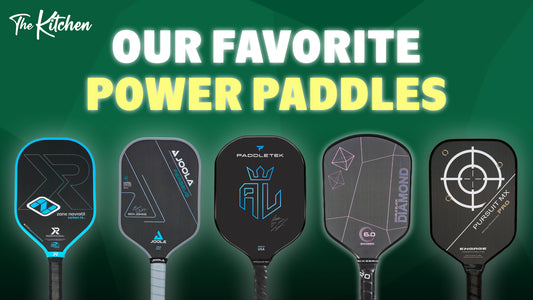-

Beginner Pickleball Player? These Paddles are for You
It’s easy to wind up in an expensive rabbit hole if you’re shopping for pickleball paddles as a beginner player. These are our suggestions.
Beginner Pickleball Player? These Paddles are for You
I just got into pickleball, or I’m about to play. Which paddle should I buy?
If you want the best value for your money – really, who doesn’t? – then this question can only be answered accurately once a couple others are answered first:
- How long do you see yourself playing for?
- How much money could you see yourself spending?
- Do you have any physical concerns like arthritis or weaker wrists?
We’ll provide some context to help you shop for paddles based on all of those core questions…but if you just want to see our paddle selections, skip to the end.
Just remember: as you go up in skill level, there’s going to be plenty of noise out there about spin, control, power, etc. – and if you’re really a beginner pickleball player, none of that matters.
What matters right now is that you find a well-made paddle that will last you as long as it needs to and feels right in your hand. Now, let’s help you find it.
Avoid The Vicious Cycle
Most new players experience a vicious cycle that goes something like this:
- I’m not going to buy a paddle. I’ll just borrow someone else’s.
- Damn, that was fun. Guess Amazon gets my $20 after all.
- *Plays a few more times* This paddle sucks. Guess Amazon gets $60 more.
Now you have two paddles and you’ve dropped about 80 bucks.
Maybe your “next step” paddle was great, maybe not. But eventually, you end up wishing you’d just spent a little more in the first place to get something that lasts (and/or fits your play style).
So we recommend you (or the person you’re convincing to play) skip all the steps up to this point and spend the money on a great paddle at a price point that isn’t as steep as the “die hard” paddles.
Of course, if you’ve already done all of that but still want to find a well-made paddle that’ll suit your play style, the following tips are just as useful.
If You’re About to Play Pickleball for the First Time…
We’d love to sell you any of the beautiful, well-made paddles below…but realistically, they may be out of your budget if you’re just trying pickleball because someone dragged you to it and you don’t even know if you like it yet.
It all depends on how long you can see yourself playing for, and while that may change depending on how your first experience goes, it’s safe to say you’ll probably enjoy playing at least a little bit if you’ve ever played ping pong, tennis, or other racquet sports before.
For $100, you can buy this Bantam TS-5 from Paddletek.
It’s definitely more expensive than the paddles you see at Target (which, to be fair, aren’t terrible if you’re really unsure about the game), but for the extra cash, you’re buying a dependably-good paddle that fits most play styles right out of the gate:
- It’s shape is forgiving for those with ping pong experience
- It’s handle length is just-right: not too long to trip you up when you’re just learning backhand groundstrokes, but not too short as to feel unnatural in the hand
- It’s lightweight but still allows you to generate power during your very first hands battle
If You’re a Tennis Player…
You’re looking for a paddle to help you transition from tennis, which is very groundstroke- and swing-heavy.
While the swinging motion in pickleball is far more compact than in tennis, you may want to consider the value of having MORE paddle in your hands.
Think of length as an asset:
- Look for handle lengths of at least 5 inches or more, if possible – this’ll make your groundstrokes (and two-handed backhands) feel more secure
- The length of the paddle’s face is also important for tennis players; look for an elongated shape that will “extend your arms” a bit during quick exchanges
For under $150, you can grab the Electrum Model E used by many on the pro tours, or the Selkirk AMPED Invikta, designed specifically for (soon-to-be former) tennis players.
For Those with Mobility Challenges
Pickleball is pretty accessible for those with mobility issues, wrist, arm, and shoulder injuries, etc.
While you should probably consult your doctor before strenuous exercise, it seems only logical you’ll want a paddle that works with you, not against you.

Look for lightweight (less than 8oz if possible) paddles with a “standard” paddle face shape (see above). This limits its “swing-heaviness,” dampening the strain on your arm and wrist over extended use.
The Holbrook Mav Pro in 13mm is light, but its thin core still packs a punch of power. For similar reasons (and a similar price), we also recommend the Paddletek Bantam TS-5.
It’s easy to wind up in an expensive rabbit hole if you’re shopping for pickleball paddles as a beginner player. These are our suggestions.
-

Mother's Day Paddles to Up Her Game (or Yours)
Pickleball may bring the world together, but moms keep the world together. It’s an important distinction. In honor of all the wonderful moms out there,...
Mother's Day Paddles to Up Her Game (or Yours)
Pickleball may bring the world together, but moms keep the world together. It’s an important distinction.
In honor of all the wonderful moms out there, we bring you our favorite paddles for this joyous Mother’s Day weekend.
Pickleball may bring the world together, but moms keep the world together. It’s an important distinction. In honor of all the wonderful moms out there,...
-
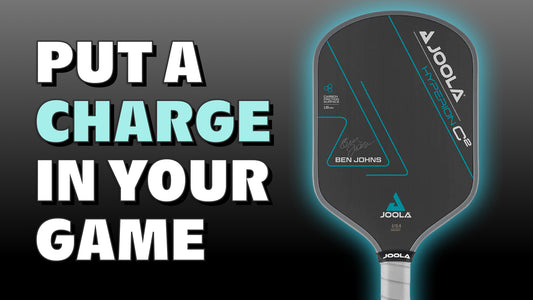
Review: JOOLA Hyperion C2
Franklin is back! It's been a while since we saw Ben Johns playing with his signature paddle and it took a minute for Franklin to...
Review: JOOLA Hyperion C2
Franklin is back! It's been a while since we saw Ben Johns playing with his signature paddle and it took a minute for Franklin to find their carbon fiber stride, but the FS Tour line of paddles has some interesting innovations and at just $150, we think it's a great deal. Franklin's FS TOur series has two shapes, and elongated Dynasty and a more traditional Tempo. They have spared no expense on this paddle with T700 Raw Carbon Fiber, thermoformed, available in both 14 and 16mm, and a choice of three colors, blue, pink, or silver. Depending on the configuration you choose, these paddles weigh in at anywhere from 8-8.9 ounces.
Franklin is back! It's been a while since we saw Ben Johns playing with his signature paddle and it took a minute for Franklin to...
-
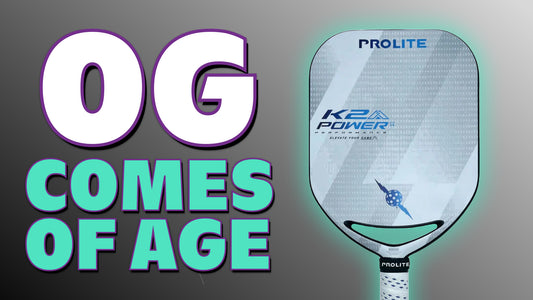
Review: Prolite K2 Power
Prolite is an OG of pickleball paddles. Started back in 1984, they were the first to evolve the game from our wooden paddle roots and...
Review: Prolite K2 Power
Prolite is an OG of pickleball paddles. Started back in 1984, they were the first to evolve the game from our wooden paddle roots and into the world of composite materials. Well, things have come a very long way from 1984 and so has Prolite. This is Prolite's first thermoformed paddle and it's quite interesting. It is designed with one of the widest hitting surfaces we have ever reviewed. The unibody construction, Open Throat System, and Permatraction coating provides a ton of spin beyond what the Toray T700 carbon finer can produce on its own.
Prolite is an OG of pickleball paddles. Started back in 1984, they were the first to evolve the game from our wooden paddle roots and...
-
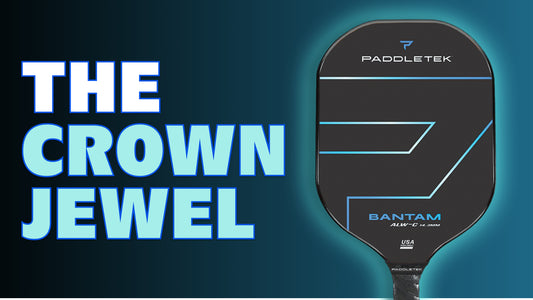
Review: Paddletek Bantam ALW-C
It feels like it's taken Paddletek a very long time to get into the raw carbon fiber game, but they have finally made the leap....
Review: Paddletek Bantam ALW-C
It feels like it's taken Paddletek a very long time to get into the raw carbon fiber game, but they have finally made the leap. And it was worth the wait, especially because the wait was warranted. They sourced raw carbon fiber that is made in America! And not only that, they found a way to enhance the T700 raw carbon fiber to have optimum power while maintaining all the grit and control of the carbon fiber. This new concoction is referred to as PT700 and it's pretty darn good. Let us know what you think and if you would want to play with this paddle.
It feels like it's taken Paddletek a very long time to get into the raw carbon fiber game, but they have finally made the leap....
-
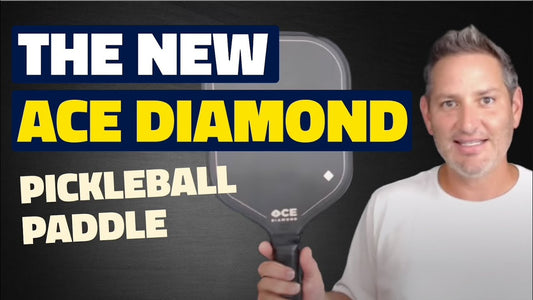
Ace Diamond Paddle Review
The Ace Pickleball Diamond is the thinnest (10 mm) carbon fiber paddle I have ever played with. So much pop, but the carbon fiber face...
Ace Diamond Paddle Review
The Ace Pickleball Diamond is the thinnest (10 mm) carbon fiber paddle I have ever played with. So much pop, but the carbon fiber face provides enough grit to shape my shots the way I want. The magic is in the core, while pretty much all other paddles use polypropylene as the material in the honeycomb core, the Diamond uses Kevlar.
This provides extra pop on all shots as well as keeping it as light as any paddle I have ever played, weighing in at only 7.4 ounces. This is the paddle that pro pickleballer Gabe Joseph has been playing with, and it makes sense because Gabe has some of the quickest hands on tour.
The Ace Pickleball Diamond is the thinnest (10 mm) carbon fiber paddle I have ever played with. So much pop, but the carbon fiber face...
GEAR
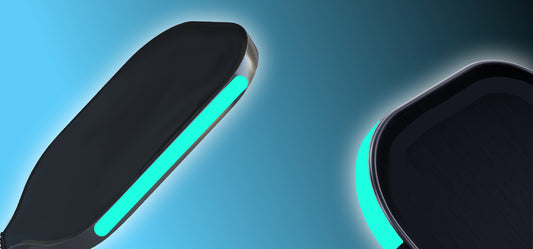
Adding Weight to Your Pickleball Paddle: The Complete Guide
Adding weight tape to your pickleball paddle is a worthwhile experiment that can lead to noticeable changes in your game. But you need to educate...
Adding Weight to Your Pickleball Paddle: The Complete Guide
There’s lots of buzz about pickleball paddle weight tape, and likewise, lots of confusion. So first things first: let’s answer some rapid-fire questions we know many of you may have already:
Is it even legal, according to USAP guidelines? Yes, paddle weight tape (or lead tape) is allowed.
Is it only for the highest-level players? No, not at all. Anyone can benefit from them, but to use them effectively, you should first understand the basics of pickleball and, more specifically, how you play it.
Will it enhance my performance on the pickleball court? Potentially, yes! But you need to know why and how to use it, which we’ll explain below.
Why You Should Use Paddle Edge Tape
Let’s level with each other: it is not absolutely critical to alter your paddle in any way. You can dive as deep as you’d like into the world of paddle technology and how to find the one that works best for you.
It’s equally legitimate to buy the cheapest paddle that feels the best in your hand as it is to base your purchase decisions on swing weight, paddle construction, and other technicalities.
But if you’re going to alter whatever paddle you’ve purchased within legal USAP guidelines, you should know the basics of why one would do so.
These are the most important reasons to add weight tape to your pickleball paddle:
Extra weight = extra power. While you can buy “lightweight,” “medium weight,” or “heavy weight” paddles, most of them weigh close to 8oz. But adding extra weight to the swinging object is always going to add more power to that object’s collision with other things (i.e. the ball).
More weight provides shot “forgiveness.” No paddle or paddle alteration could ever make up for bad technique. But sometimes, your swing is only off by a little bit, resulting in an impact just outside of your paddle’s sweet spot and destabilizing it in the hand. You can reduce shot errors caused by destabilization by adding weight to a paddle’s edges.
Adding weight changes the sweet spot. Not only does adding weight increase a paddle’s power output, it also alters the size and location of its sweet spot, or the location where balls bounce off with the most power and accurate response.
Before you begin placing weight on your pickleball paddle, consider the possibility that doing so may cause injury over time.
Even players who refrain from using extra weights sometimes cause strain on the small muscles and tendons in their arms and wrists just by playing too much pickleball.
That risk is compounded by adding additional weight to your paddle, so be sure to monitor yourself for any unusual aches after playing and consult your doctor if any discomfort arises.
Where to Put Weights on a Pickleball Paddle
Now that we’ve answered the “why,” it’s time for the “how.”

Adding Weight to the Paddle Head
Imagine swinging a golf club while holding its handle. You’ll feel the weight where it’s supposed to be: down near the ball, and you’ll be able to feel that weight extend and amplify as your swing reaches its nexus.
Now imagine swinging that golf club while holding it near the head. Even if you placed a golf ball on a giant tee that brought it up to waist height, the swing itself would feel awkward and much weaker than normal.
Likewise, adding weight to the top (“head”) of your paddle slows down your swing and adds power. Obviously, pickleball is different from golf, so is this always the ideal move for pickleball players?
No, probably not. If you lack power in terms of your muscle mass (not because of bad shot technique), you may risk injuring yourself over time by making the paddle top heavy.
But if you have developed your arm and wrist muscles and feel more comfortable adding top-heaviness to your paddle, you may be able to accentuate your strength to become a power-focused player by adding tape to this spot.
Adding Weight to the Middle/Sides of Your Paddle
The spot most players add weight to is the center/sides of their paddle, and the reason is very clear.
It’s like fortifying a house’s walls with a layer of cement. Adding tape to the sides makes the paddle more stable in the hand and expands the sweet spot closer to the taped sides.
While technique is king, stabilizing a paddle in this way can expand the area of the paddle’s accuracy.
If you often feel your paddle’s face jolt to one side after hitting the ball outside of center, you should experiment with this technique.
Adding Weight to the Paddle’s Neck
That curvy spot between the lower end of the paddle face and the handle is another common spot for adding weight tape.
Adding weight here will add stability, perfect for those who miss more shots on the lower half of their paddle.
Related: 3 Pickleball Paddles for Control (And What that Really Means)
Other Pickleball Paddle Weight Configurations
You may also see players apply weight to the four “corners” of their paddle. This boosts power considerably and adds lots of stability.
But it also slows hand speed and adds noticeable weight, which may negatively affect those with weaker wrists and forearms.
Players also may choose to add weights over or under their paddle’s grip. This can make a paddle feel extra maneuverable at the kitchen line during fast hands battles while also adding a thicker, grippier feel to its handle.
Note, you’ll still need more energy to swing the paddle no matter where you add weight.
In short: you probably SHOULD try adding weight to your paddle. But you probably SHOULD NOT do it until you critically analyze your game and make note of which situations cause you to make the most errors.
Use the same paddle for a while, then ask yourself:
Do I lack power but feel stable at the kitchen line? If so, add a little weight to the top or top corners.
Am I more concerned with shot placement and accuracy during hands battles? If so, add some to the sides of the paddle, experimenting with how far down you go.
Does my paddle work well for me, but feel a little top-heavy? If so, add weight to the curved part near the bottom.
Do I wish my grip was just a little bigger? Adding under- or over-grip weight (or even just an extra layer of grip tape) may help.
Most weight tape is made with lead, but some are tungsten-based. Tungsten tape tends to be somewhat lighter and typically comes in weights of 1-2 grams per piece, while lead tape options tend to weigh 2-3 per piece.
One final piece of advice: don't add too much too soon. Start with one piece of tape in each spot and add more in small increments until you achieve what you set out to do in the first place...
...And if you don't have a desired result in the first place, re-read this article and examine your game. Maybe you don't ultimately need any paddle alterations. That's ok, too. But it's worth messing around with.
Shopping for Pickleball Paddle Weights? Look No Further
Check out the products on the right side of this page.
Adding weight tape to your pickleball paddle is a worthwhile experiment that can lead to noticeable changes in your game. But you need to educate...

Power Pickleball Paddles: Who Should Buy Them
How much do pickleball paddles matter, really? And when should you consider a power paddle vs. a control paddle? We provide the answers.
Power Pickleball Paddles: Who Should Buy Them
The mantra, “it’s all in the player, not the paddle” is true – but it doesn’t answer the simple questions most players have.
Do pickleball paddles really matter? And, should I buy a power paddle or a control paddle?
The answers to both of those questions can be as complex and technical – or simple and straightforward – as you’d like.
But you should have at least a little context if you’re about to go paddle shopping (which you should totally do here, by the way).
What a Power Pickleball Paddle Really Is
"Power paddles are the best choice for players who dominate the court with strength and speed” says Tom Barnes, Director of Research & Development at Selkirk.
“Crafted for those who wield dynamic swings, power paddles are meticulously engineered with advanced materials that amplify aggressive gameplay. Their distinctive elongated shape and heavier weight afford extra leverage and extended reach, packing a forceful punch on each shot."
Let’s break that down a bit.
When it comes to power paddles, it’s all about energy absorption. The paddle face material addresses that concern directly.
Paddle faces made out of fiberglass provide flexibility, creating a springboard-like effect when the pickleball bounces off. But these paddles are sometimes less durable than those made with other materials, such as carbon fiber.
Speaking of…carbon fiber is popular these days because it increases the sweet spot of the paddle overall and provides a “best of both worlds” approach to power versus control (more on that below).
The paddle’s shape also plays an important role. There’s the standard, or wide-body shape, the elongated shape, or something in-between.
This factor changes weight distribution. The more difficult it is to swing a paddle fast, the more powerful it can be, so the elongated shape is typically used to accentuate power in a paddle. Of course, this shape also offers additional reach and leverage.
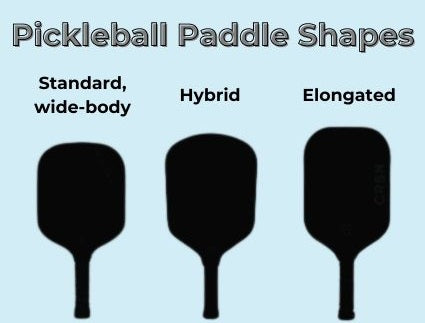
Paddles with thinner cores also provide more power. Look for 13mm or thinner core thickness.
Finally, a good rule of thumb is: if there’s more paddle, there’s more power. Like a carrying a long sword instead of a rapier, one is good for huge attacks, while the other suites fast hands and complete control.
Heavier paddles with weights over 7.5 oz and extended handle lengths of 5 inches and above will provide more reach and allow for powerful shots such as the two-handed backhand.
“Pop,” Thickness, and Dwell Time
Here’s where it gets complicated.
Surely you’ve heard the term “pop” if you’ve ever considered buying a new paddle. It’s slung around like a singular technical term but its impact on performance is a little more complicated.
Thick paddle cores encourage more “dwell time,” or the amount of time the ball stays on the paddle. Like a pillow, the ball can sink in slightly more, meaning the rebound – or pop – is diminished.
But because you have more time with the ball on the paddle, your stroke technically lasts a little longer.
We said above that thinner cores = more power, and that’s technically true.
But if you have incredible pickleball technique, thicker paddles may in fact suit you better, where thinner paddles give you a bit of immediate help in the power department no matter the quality of your form.
In summary:
- Thinner paddles = firm backboard, more upfront “pop”
- Thicker paddles = flexible backboard, more power generated by staying on paddle longer
Who Should Buy a “Power Paddle”
Austin Kim, product manager of hardline products at JOOLA, says most recreational players should probably not worry too much about adding tons of power to their game via a power-focused paddle.
“A control-focused paddle should be the direction you go in most of the time. Obviously, we try to blend both power and control into most of our paddles, but a power-focused paddle is geared for those with incredibly soft hands; those who are dialed in to most shots and the mechanics of the game.”
Think of automobiles: most people should probably drive Camrys and Civics for their everyday driving needs. But manufacturers also design Ferraris for enthusiasts or those with specific speed needs.
That said, it never hurts to experiment with different paddle styles as you never know what is going to surprise you.
If you like resets and dinking, you’re generally geared for a control-focused paddle, but if you lack power in a major way, perhaps a power paddle could make up for your weak spot.
If you play singles often, elongated paddle shapes with thin cores will help you cover more of the court.
Power Paddles vs. Control Paddles
The reality is that most paddles are a little bit “power,” a little bit “control,” with the balance swaying depending on the model and all of the traits listed in the first section of this article.
For more on control paddles and some excellent examples, click here.
Again, most paddles still have a great deal of control-focused elements blended into their design. It does truly all come down to the player and their techniques.
Some of the Best Power Pickleball Paddles Money Can Buy
Below, we've included a few of our store's most popular power-focused paddles.
But even though it isn't in our store (yet!), you should know about JOOLA's new Gen 3 series. Find our review here for everything you need to know.
How much do pickleball paddles matter, really? And when should you consider a power paddle vs. a control paddle? We provide the answers.
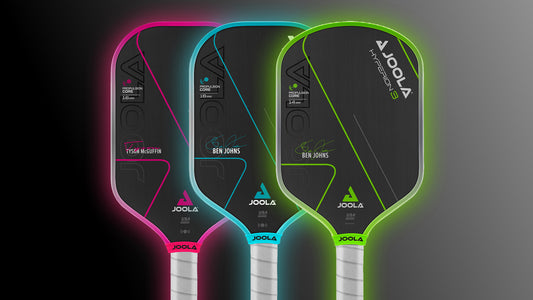
Joola Gen 3 First Look: Paddle Technology Pushed to the Limit
Joola Gen 3 pickleball paddles - the Hyperion, the Perseus, the Scorpius, and the new Magnus - feature some refreshingly-original technology.
Joola Gen 3 First Look: Paddle Technology Pushed to the Limit
Joola just dropped its Gen 3 series of paddles: the Hyperion, the Perseus, the Scorpius, and the new Magnus shape.
As people who write about (and sell!) paddles, we have to admit...this new series is one of the most important pickleball product launches in the history of the sport, and we have more than enough to back that up.
But there's a catch. As the Kitchen's Jason Aspes put it in his video review (below): these paddles will undoubtedly change YOUR game. But are they good for THE game?
What Makes Joola Gen 3 Technology Unique?
At a certain point, a paddle is a paddle is a paddle, right? Not this time.
The usual specs that you'd expect to see on a modern carbon fiber pickleball paddle are there, of course:
- An array of shape options, optimizing for control versus power and other factors
- Different thickness options (14mm vs. 16mm) across the line
- Foam injected into paddle's perimeter for increased stabilization
- Honeycomb polymer core
But here's where it gets interesting. These things hit H-A-R-D.
Joola is using what they call "propulsion core" technology. The core of the paddle is a polypropylene core, much like we've seen in the past. And it has a carbon fiber face like we've seen in the past.
But the edge wall foam is made in a specific way that allows the core to essentially flex, almost like a catapult. The result is a paddle 'dwell time' when the ball hits the face.
We caught up with world no. 1 Ben Johns about the new line. Watch the whole interview below:
In short: more spin, more power, more pop. A LOT more. We can barely comprehend how the paddle meets USA Pickleball guidelines.
"We can debate all we want....Oh, it's just a piece of plastic. But guess what? If it hits you in the eye, that leaves permanent damage, and we don't want that."
Safety aside, we have to wonder if this kind of technology alters the game of pickleball itself.
Get ready to change how you counter a player wielding one of these. You're going to need to perfect power punches instead of soft resets.
And what good will a third shot drop be for players who have such powerful tech in their hands?
If all of this sounds a bit panicked, just wait until you try one of these Gen 3 paddles. We're serious: they feel and play differently than we're used to, and we've played with a lot of paddles.
Jason says he doesn't blame Joola for these advancements, though.
"I think Joola has been amazing at innovating these paddles. I'm having a lot of fun playing with this paddle. The engineering is phenomenal, and they did this all within USAP guidelines for paddle construction.
"Now, I'd like to see USAP change their guidelines so we don't let this game get out of hand."
A first-of-its-kind "smart paddle"
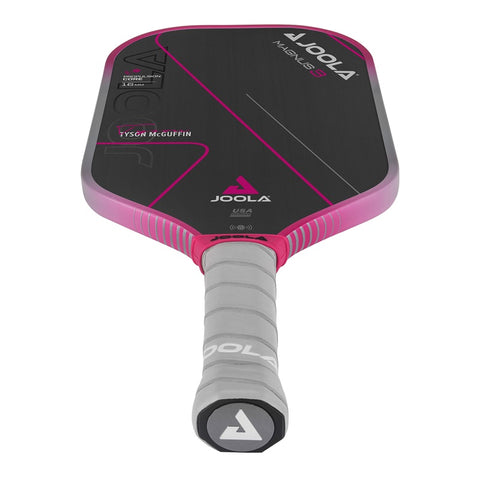
Tyson McGuffin Magnus 3, 16mm
Not only do these paddles come with jaw-droppingly powerful performance, they also come equipped with technology we just haven't seen before in paddles.
We've officially entered the age of "smart pickleball paddles." When you hold your phone up to the handle of one of the Gen 3s, there's an NFC chip that communicates with your phone.
Read Next: Our Favorite Paddles for Power
You can use this feature to do any number of things pertinent to your investment:
- Register your paddle and receive a copy of your warranty
- Connect to the Joola Infinity app, featuring lessons, tips, and strategies
The new Joola paddles will run you $279.95.
You can order them now at Joola, or you can wait a week and starting on April 23rd, you can get them at other retailers, including our store.
Joola Gen 3 pickleball paddles - the Hyperion, the Perseus, the Scorpius, and the new Magnus - feature some refreshingly-original technology.
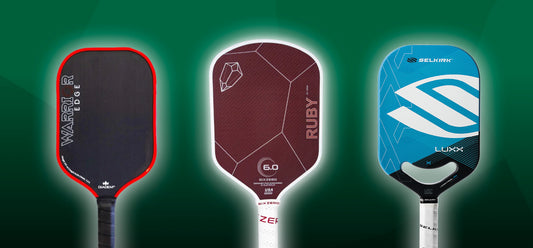
3 Pickleball Paddles for Control (And What that Really Means)
What really is a “control paddle,” and do you need one for your pickleball play style? We explain it and highlight a few of the...
3 Pickleball Paddles for Control (And What that Really Means)
You’ve probably seen the term “control” anywhere you’ve ever shopped for pickleball paddles.
Control paddles represent an entire category these days…which is great for manufacturers, since it’s the type of industry jargon that sounds easy to market. Doesn’t everybody want a “control-focused” paddle to some extent?
This is the type of term that you may feel you understand through how it's used in context.
But there’s much more of a technical meaning behind what makes a control paddle that you should understand if you want to choose one that truly matches your play style.
Here’s what you need to know about control pickleball paddles:
Who They’re Made For
"Control paddles are purposefully designed for players who prefer to use finesse rather than sheer power on the pickleball court,” says Rob Barnes, co-founder and co-CEO of Selkirk Sport.
“Control paddles typically feature a thicker core, a lighter weight, materials such as graphite and carbon, and a shorter, wider paddle face to enhance the sweet spot."
Control paddles are typically engineered for players who like to control the pace of the ball. Example: a slowdown volley or a soft dink reset at the kitchen line.
This is where “soft hands” come into play. If you’re a player who resists the urge to smash the ball every time, you’ll probably want to consider a control paddle.
Likewise, if you’re an athletic player who’s already capable of generating plenty of power and spin, a control paddle may help balance your game.
But don’t think your decision should end there…
The Limits of “Control”
Every paddle has its limits. One important thing to remember is that a truly great paddle should balance certain aspects to cover for the weak points of its design.
In the case of control paddles, power is the thing you’ll need to provide.
If you need a little help in the power department but still want a control-focused paddle, look for these qualities:
- A midweight design (between 7.3 and 8.3 oz), which tends to balance the two opposing qualities of power and control
- A carbon fiber paddle face
- A longer handle, which makes it easier to add a second hand to your backhand (and increase the amount of potential power you can add to this shot)
If you’re a high-level player looking to compete, you may consider pursuing more of a power paddle for the simple reason that other competitors are likely using them. Read more on power paddles here.
High level players are able to control the ball in a fundamentally different way than those of lower levels, so at a certain point, the advantage comes from power added.
3 Great Control Pickleball Paddles
What really is a “control paddle,” and do you need one for your pickleball play style? We explain it and highlight a few of the...
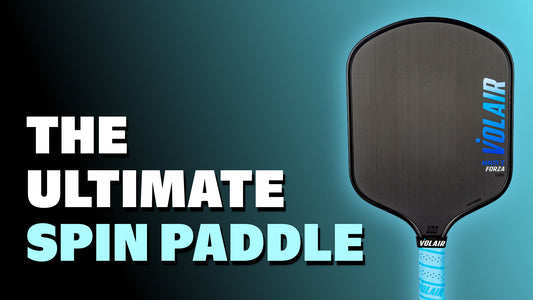
Volair Mach 2 Forza Paddle Review
Volair is back at it with the new Mach 2 Forza. This thermoformed paddle comes in both a 14mm and 16mm thickness. The Mach 2...
Volair Mach 2 Forza Paddle Review
Volair is back at it with the new Mach 2 Forza. This thermoformed paddle comes in both a 14mm and 16mm thickness. The Mach 2 is the traditional shape while the Mach 1 is the elongated version. This Mach 2 Forza sports Toray T700 carbon fiber that is as gritty as any paddle we have ever played. If you want more spin, this is the paddle for you!
Volair is back at it with the new Mach 2 Forza. This thermoformed paddle comes in both a 14mm and 16mm thickness. The Mach 2...
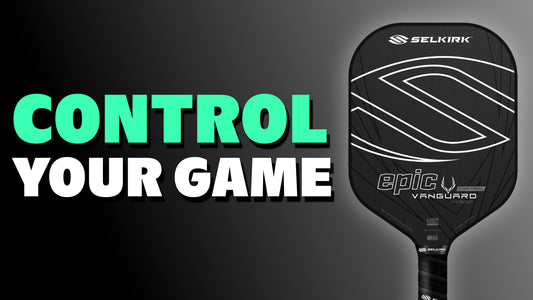
Review: Selkirk Vanguard Control
The Vanguard Control is the latest paddle from Selkirk. The paddle is 16mm thick and comes in a charcoal gray color. They borrowed the X5+...
Review: Selkirk Vanguard Control
The Vanguard Control is the latest paddle from Selkirk. The paddle is 16mm thick and comes in a charcoal gray color. They borrowed the X5+ Core from project 006, along with the QuadCarbon technology on the face, and have created one of the most comfortable paddles we have ever played with. This is a control paddle that gives you so much confidence in your shots, you simply won't miss the power you are lacking.
The Vanguard Control is the latest paddle from Selkirk. The paddle is 16mm thick and comes in a charcoal gray color. They borrowed the X5+...
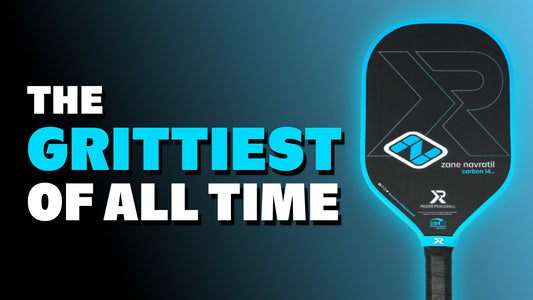
Review: ProXR Zane Navratil Signature
This is a look at the ProXR Zane Navratil Signature paddle. The base model of this paddle is called "The Standard" and what is different...
Review: ProXR Zane Navratil Signature
This is a look at the ProXR Zane Navratil Signature paddle. The base model of this paddle is called "The Standard" and what is different about Zane's model is that it has a longer handle (6" as opposed to 5.25") and it only comes in 14 mm, where the standard is both 14 and 16mm. It's a crisp paddle, with an iconic baby blue edge guard but also comes in multiple colors.
This is a look at the ProXR Zane Navratil Signature paddle. The base model of this paddle is called "The Standard" and what is different...
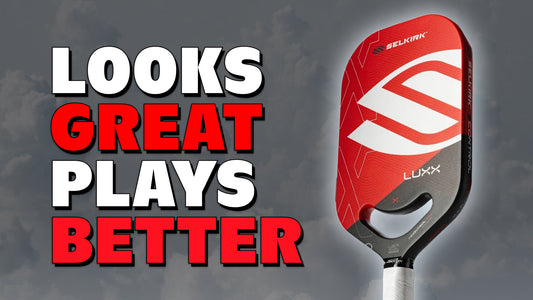
Review: Selkirk Luxx Control Air
Selkirk is at it again, this time taking their Project 003 and somehow improving upon it for the launch of the Luxx Control Air. This...
Review: Selkirk Luxx Control Air
Selkirk is at it again, this time taking their Project 003 and somehow improving upon it for the launch of the Luxx Control Air. This paddle doesn't just look great, it plays even better. Sporting a massive 20mm core, the touch and feel is exactly as you would expect, but the power does not seem to be compromised.
Selkirk is at it again, this time taking their Project 003 and somehow improving upon it for the launch of the Luxx Control Air. This...
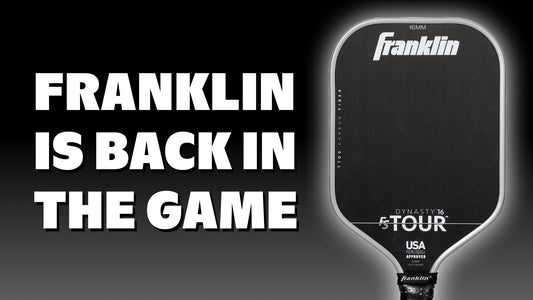
Review: Franklin FS Tour
Franklin is back! It's been a while since we saw Ben Johns playing with his signature paddle and it took a minute for Franklin to...
Review: Franklin FS Tour
Franklin is back! It's been a while since we saw Ben Johns playing with his signature paddle and it took a minute for Franklin to find their carbon fiber stride, but the FS Tour line of paddles has some interesting innovations and at just $150, we think it's a great deal.
Franklin's FS Tour series has two shapes, and elongated Dynasty and a more traditional Tempo. They have spared no expense on this paddle with T700 Raw Carbon Fiber, thermoformed, available in both 14 and 16mm, and a choice of three colors, blue, pink, or silver. Depending on the configuration you choose, these paddles weigh in at anywhere from 8-8.9 ounces.
Franklin is back! It's been a while since we saw Ben Johns playing with his signature paddle and it took a minute for Franklin to...
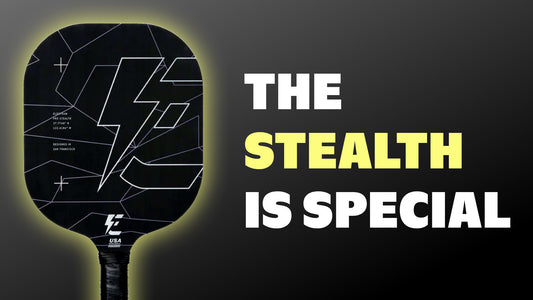
Electrum Stealth Paddle Review
Electrum is one of the innovators of the carbon fiber trend which has become ubiquitous in pickleball paddles. Their newest paddle, the Stealth, which comes...
Electrum Stealth Paddle Review
Electrum is one of the innovators of the carbon fiber trend which has become ubiquitous in pickleball paddles. Their newest paddle, the Stealth, which comes in 3 different shapes (Pro, Pro II, and Model E) is one of the few edgeless thermoformed paddles on the market. It is super light and great for maneuverability at the kitchen line. The 16mm core provides all the feel and touch that you would expect but doesn't sacrifice much power at all. If you were to add a little weight to the paddle, you would not only extend the sweet spot, but also generate a bit more power if necessary.
Electrum is one of the innovators of the carbon fiber trend which has become ubiquitous in pickleball paddles. Their newest paddle, the Stealth, which comes...

Review: JOOLA Hyperion C2
Franklin is back! It's been a while since we saw Ben Johns playing with his signature paddle and it took a minute for Franklin to...
Review: JOOLA Hyperion C2
Franklin is back! It's been a while since we saw Ben Johns playing with his signature paddle and it took a minute for Franklin to find their carbon fiber stride, but the FS Tour line of paddles has some interesting innovations and at just $150, we think it's a great deal. Franklin's FS TOur series has two shapes, and elongated Dynasty and a more traditional Tempo. They have spared no expense on this paddle with T700 Raw Carbon Fiber, thermoformed, available in both 14 and 16mm, and a choice of three colors, blue, pink, or silver. Depending on the configuration you choose, these paddles weigh in at anywhere from 8-8.9 ounces.
Franklin is back! It's been a while since we saw Ben Johns playing with his signature paddle and it took a minute for Franklin to...

Review: Prolite K2 Power
Prolite is an OG of pickleball paddles. Started back in 1984, they were the first to evolve the game from our wooden paddle roots and...
Review: Prolite K2 Power
Prolite is an OG of pickleball paddles. Started back in 1984, they were the first to evolve the game from our wooden paddle roots and into the world of composite materials. Well, things have come a very long way from 1984 and so has Prolite. This is Prolite's first thermoformed paddle and it's quite interesting. It is designed with one of the widest hitting surfaces we have ever reviewed. The unibody construction, Open Throat System, and Permatraction coating provides a ton of spin beyond what the Toray T700 carbon finer can produce on its own.
Prolite is an OG of pickleball paddles. Started back in 1984, they were the first to evolve the game from our wooden paddle roots and...
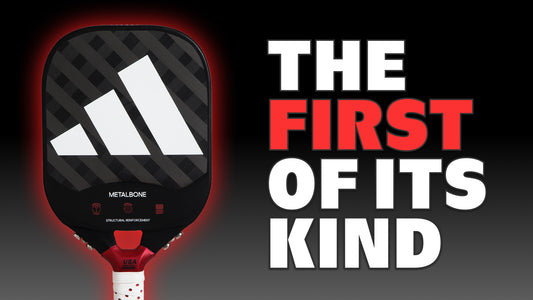
Adidas Metalbone Paddle Review
The Adidas Metalbone is unlike any paddle we have played to date. The first thing you will notice is the weight and balance system. This...
Adidas Metalbone Paddle Review
The Adidas Metalbone is unlike any paddle we have played to date. The first thing you will notice is the weight and balance system. This is a innovative approach to building a self regulating system into the paddle itself to manage the weight distribution of the paddle.
There are two screws and three holes on either side of the paddle face to place the screws, providing a personalized swing weight. The core is made of PMI, a material we have yet to play with in a paddle and provides a ton of power. The Metalbone is a huge step in the right direction for Adidas and a paddle worth checking out.
The Adidas Metalbone is unlike any paddle we have played to date. The first thing you will notice is the weight and balance system. This...

Review: Paddletek Bantam ALW-C
It feels like it's taken Paddletek a very long time to get into the raw carbon fiber game, but they have finally made the leap....
Review: Paddletek Bantam ALW-C
It feels like it's taken Paddletek a very long time to get into the raw carbon fiber game, but they have finally made the leap. And it was worth the wait, especially because the wait was warranted. They sourced raw carbon fiber that is made in America! And not only that, they found a way to enhance the T700 raw carbon fiber to have optimum power while maintaining all the grit and control of the carbon fiber. This new concoction is referred to as PT700 and it's pretty darn good. Let us know what you think and if you would want to play with this paddle.
It feels like it's taken Paddletek a very long time to get into the raw carbon fiber game, but they have finally made the leap....

Ace Diamond Paddle Review
The Ace Pickleball Diamond is the thinnest (10 mm) carbon fiber paddle I have ever played with. So much pop, but the carbon fiber face...
Ace Diamond Paddle Review
The Ace Pickleball Diamond is the thinnest (10 mm) carbon fiber paddle I have ever played with. So much pop, but the carbon fiber face provides enough grit to shape my shots the way I want. The magic is in the core, while pretty much all other paddles use polypropylene as the material in the honeycomb core, the Diamond uses Kevlar.
This provides extra pop on all shots as well as keeping it as light as any paddle I have ever played, weighing in at only 7.4 ounces. This is the paddle that pro pickleballer Gabe Joseph has been playing with, and it makes sense because Gabe has some of the quickest hands on tour.
The Ace Pickleball Diamond is the thinnest (10 mm) carbon fiber paddle I have ever played with. So much pop, but the carbon fiber face...
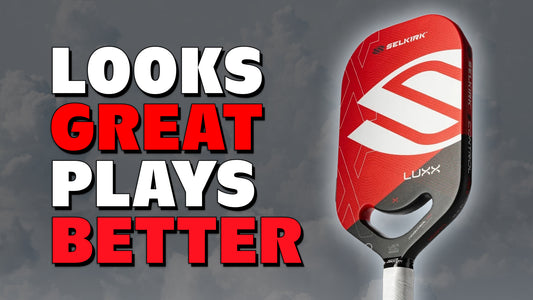
Selkirk Luxx Control Air Paddle Review
Check out our review of the Selkirk Luxx Control Air!
Selkirk Luxx Control Air Paddle Review
Selkirk is at it again, this time taking their Project 003 and somehow improving upon it for the launch of the Luxx Control Air. This paddle doesn't just look great, it plays even better. Sporting a massive 20mm core, the touch and feel is exactly as you would expect, but the power does not seem to be compromised.
Check out our review of the Selkirk Luxx Control Air!



